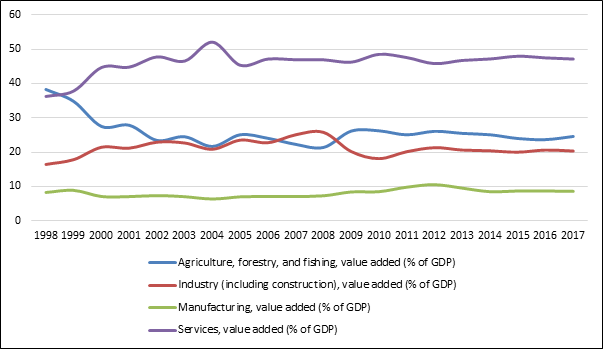
Issue 7 | August 23, 2019
Critical Issues Uganda Should Address to Industrialise
By Susan Kavuma, PhD |Research Associate |ACODE | @ACODE_Uganda
 Industrialisation is projected as the impetus for economic development and African countries are committed to it as expressed in Africa’s Agenda 2030 and 2063. The Agenda 2030 and more specifically Sustainable Development Goal (SDG) nine urges countries to promote sustainable industrialisation by investing in scientific research and innovation. The Agenda 2063 advocates for the promotion of sectoral and productivity plans as well as the development of regional and national commodity value chains as a pre-requisite for the implementation of industrial policies1. For a very long time, Uganda has aspired to industrialise and has formulated strategies for industrialisation in its development plans. The general consensus in all these development agendas is that industrialisation can enhance inclusive growth, creation of jobs and development of other growth sectors.
Industrialisation is projected as the impetus for economic development and African countries are committed to it as expressed in Africa’s Agenda 2030 and 2063. The Agenda 2030 and more specifically Sustainable Development Goal (SDG) nine urges countries to promote sustainable industrialisation by investing in scientific research and innovation. The Agenda 2063 advocates for the promotion of sectoral and productivity plans as well as the development of regional and national commodity value chains as a pre-requisite for the implementation of industrial policies1. For a very long time, Uganda has aspired to industrialise and has formulated strategies for industrialisation in its development plans. The general consensus in all these development agendas is that industrialisation can enhance inclusive growth, creation of jobs and development of other growth sectors.
The role of industrialisation in the economic development process cannot be over-emphasized because of its impact on linkages in the economy. Industrialisation increases the value created along the value chain and boosts productivity by introducing new technologies and techniques. Once again, Uganda’s theme for the 2019/2020 – 2023/2024 Budget Framework paper (BFP) is ‘Industrialisation for Job Creation and Shared Prosperity’. In the BFP, government commits to promoting industrialisation through pursuing import substitution and export promotion strategies. Since, Uganda has an agricultural based economy, industrialisation is expected to be predominantly agro-based and government has proposed key interventions to boost agricultural production and productivity. Popular among these interventions is the provision of water for production; improving extension service management; intensifying agricultural research; improving land administration; rolling out agricultural insurance schemes and promoting rural based agro-industries.
Conceptualizing industrialisation
The starting point of industrialisation is to rightly define it. Traditionally, industrialisation is known as a shift from agriculture to manufacturing sector. However, contemporary industrialisation is defined as a process that entails a change in structure, technology and organisation of economic activity2. It is a structural transformation from low productive traditional economic activities to high productive modern economic activities3. Therefore the process of industrialisation has a broad scope not limited to development of certain sectors but a change in the structure, technology and organisation of economic activity in any sector. The key indicator for industrialisation is manufacturing value added (MVA) which should be used to measure progress in industrialisation. In Uganda, the value addition in the agriculture sector has remained low below 30% of GDP as shown in Figure 1. In view of the trend in Figure 1, as Uganda advocates for agro-based industrialisation, it should critically analyse the impediments to creating value along the value chain of agricultural products.
Figure 1: Trend in Value Added as Percentage of GDP by Sector
(Source: World Development Indicators)

Promoting private sector led industrialisation
Since, Uganda pursues a private-sector led growth strategy it expects the private sector to lead the industrialisation process. However, Uganda’s private sector is weak because it is dominated by micro, small and medium enterprises (MSMEs) which constitute more than 93% of total enterprises4. These enterprises have a high ‘mortality’ rate characterised with low efficiency and returns. Development literature5 suggests that in the event that the market (private sector) and the state are weak, the state should lead the industrialisation process. Therefore, government should ensure that it makes Uganda’s private sector stronger. This can be done in several ways. Government could embark on the process of rationalising the small firms into large firms which are more likely to raise the required capital for industrialisation than small firms. At the heart of rationalisation of firms is the need to formalise firms, a process which can only be successful if the benefits of formalising firms are significant and thereby create incentives for formalisation. Besides, large firms are more likely to integrate in the global economy than small firms.
Alternatively, government can identify sunset industries which have less potential for industrialisation and sunrise industries which have a high potential for industrialisation. In view of the statistics in Table 1, it is clear that agro-based industries in food processing, textile and chemical sub-sector present a case of sunrise industries. Given that Uganda has limited financial resources, it is prudent for the country to pursue an industrial policy that targets specific sectors. For example, the textile sub-sector should be encouraged to grow further given that it has readily available raw materials and forward linkages which can enable the country achieve its growth objectives such as promoting inclusive growth and creation of jobs. However, for the textile and footwear industry to flourish, it will require government to pursue an inward looking strategy (import substitution) that discourages the importation of second-hand clothes and shoes. Therefore industrialisation should be handled holistically by revising existing policies that are not in tandem with the appropriate strategies to industrialise Uganda’s economy.
Table 1: Index of Production, Annual Percentage Changes (2002=100), 2012 -2016
Description |
2012 |
2013 |
2014 |
2015 |
2016 |
Total Manufacturing |
3.6 |
2.9 |
10.4 |
0.9 |
5.4 |
Food processing |
8.9 |
10.6 |
20.4 |
-11.6 |
10.6 |
Drinks and Tobacco |
5.9 |
-1.9 |
10.3 |
0.6 |
-0.9 |
Textiles, Clothing and Footwear |
1.9 |
-27.7 |
-16.2 |
8.3 |
21.8 |
Sawmilling, paper and printing |
10.3 |
6.2 |
-10.5 |
10.7 |
2.1 |
Chemicals, paint, soap and foam products |
-4.4 |
-2.4 |
4.5 |
24.6 |
9.9 |
Bricks and cement |
-1.8 |
4.7 |
-3.0 |
18.7 |
0.1 |
Metal products |
-7.1 |
6.2 |
4.8 |
7.1 |
-2.4 |
Miscellaneous |
-2.9 |
5.7 |
18.1 |
5.0 |
7.1 |
Source: Statistical Abstract (UBOS, 2017) |
Role of Government in the industrialisation process
As earlier discussed, Uganda’s private sector is weak and therefore it is prudent that government takes lead in the industrialisation process. Uganda should transition into a development state that supports the private sector to generate wealth and achieve national economic growth. Specifically, government should address three key issues: i) create a competitive market; ii) integrate Uganda’s economy in the global economy and iii) address negative aspects of growth. In order for Uganda to offer a competitive business environment, there must be deliberate efforts to reduce the cost of doing business, enforcement of property rights (factor and product markets), rule of law and fighting corruption. The country must open up to both capital inflows (foreign direct investments) and income generation (regional and global markets) which will generate the required capital and technology for industrialisation. Uganda should pursue deliberate efforts to access regional and international markets through bilateral and multilateral negotiations. Once, the country has attained growth, it is incumbent upon the state to address the negative aspects of growth such as income inequality, environmental pollution, corruption, crime and materialism. In particular, addressing income inequality leads to a more equitable distribution of income which can boost domestic demand required to create a market for industrial products.
Objectives of the Industrial policy
The bedrock for industrialisation is the industrial policy, which should address particular issues. The policy should aim to promote technological capabilities through the education system by training critical thinkers, more scientist and engineers to facilitate technological transfer. Technological change creates rents and together with economies of scale, provides incentives for firms to innovate which boosts industrialisation. Secondly, the policy should aim at building the capacity of domestic manufacturers to produce value added or intermediate goods (e.g. packed juices, plastics and steel) by removing bottlenecks to value addition processes and creating a market for industrial products. Thirdly, the policy should direct investments to ensure resources are deployed to enhance economic growth. For example government can discourage the allocation of capital to economic activities with fewer opportunities for technological advancement such as real estates to promote sunrise industries, develop industrial parks and demonstration farms. Fourthly, the policy should promote exports by providing trade facilitation and the required infrastructure. The promotion of production of exports should be complemented with an appropriate marketing strategy aimed at increasing the demand for our exports through promotional campaigns within the region and beyond. Fifthly, the policy should address all forms of market failure that hinder industrialisation in Uganda such as a weak capital and land market, insecure property rights and limited provision of public goods especially the physical and economic infrastructure.
-----------------------
1 African Development Bank Group (2018). ‘Industrialise Africa’.
2 Lowit, S. (2011) Current issues and debates in industrial policy – some reflections for the Southern African Customs Union (SACU)
3United Nations Industrial Development Organisation (2015) ‘Industrialisation, Innovation and Inclusion’. Inclusive and Sustainable Industrial Development Working Paper Series WP15/2015
4 Uganda Bureau of Statistics (UBOS, 2011), ‘Census of Business Establishments, 2010/11’
5 Joseph Stiglitz (1996). ‘Some Lessons from the East Asia Miracle’. The World Bank Research Observer, Vol. 11, no. 2
|
|





+256 312 812 150 | Leave a comment | Center for Budget and Economic Governance
Subscribe To Our News Letter | Edit Subscription | Unsubscribe